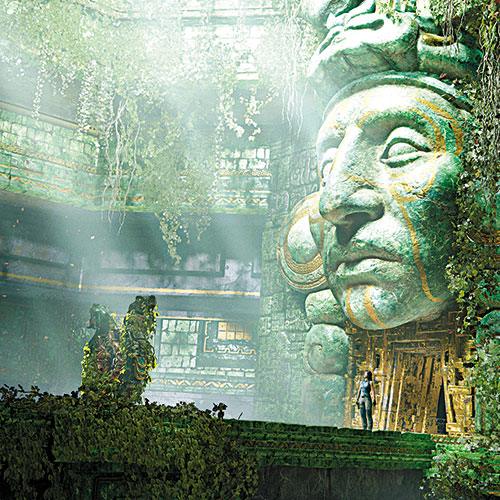New and Improved Character Kicks Off New Trilogy

Platform: Xbox One, PlayStation 4, PC
Genre: Action-adventure game
Developer: Crystal Dynamics, Eidos Montreal
Rating: : M, for Mature
By Gieson Caecho | The Mercury News (TNS)
“Tomb Raider” has always danced on the knife’s edge of reality and myth. The franchise works best when it falls on the side of believability. Lara Croft can explore legendary crypts and battle undead samurai, but without the adventure being grounded in a sensible world, the magic of the game begins to fray.
“Shadow of the Tomb Raider” constantly teeters between the two. The final entry to the rebooted trilogy wraps up Lara’s first story arc as she pursues the secretive Trinity organization to Cozumel, Mexico. Desperate to stop the group that killed her father, she beats them to a knife called the Key of Chak Chel, and during the rush to retrieve it, she unknowingly starts the Mayan apocalypse.
That begins the race between Lara and Trinity leader Dr. Dominguez, for a Silver Box that can stop the cataclysm and give the holder the power to remake the world. It’s a quest that has global ramifications and stretches the fabric of plausibility.
At the start of the campaign, “Shadow of the Tomb Raider” handles the apocalypse and Lara’s role in it with an intriguing mystery. Crystal Dynamics and Eidos Montreal wrap the potential apocalypse in cloud of possibility. Players don’t know if the legend is real or metaphorical. They can even question if Lara is the hero in the scenario when compared to the charitable leader Dr. Dominguez.
But as players advance further in “Shadow of the Tomb Raider,” the mystery and gameplay loses its luster. Veterans of the reboot will feel at home with this adventure and its new wrinkles. Lara still relies on her bow and climbing gear. She added a grappling axe and the ability to rappel down cliffs. This opens up new verticality in the world design and creates a situation where traversal becomes a puzzle in its own right.
When it comes to combat, Lara adds a few new moves to improve her stealth. She can cover herself in mode like Arnold Schwarzenegger in “Predator” to hide against vined walls and in other areas. She can climb trees, attack enemies and hang their bodies from above, hiding them from others. The stealth gameplay is as satisfying as ever.
“We wanted this to be a more capable Lara,” said Rich Briggs, Crystal Dynamics’ senior brand director. “She’s at the height of her skills.”
That means “Shadow of the Tomb Raider” has less of an emphasis on Metroidvania-type gating. Lara learns fewer new abilities and those powers don’t have a huge impact on exploration. A required tool, such as a reinforced knife or shotgun, blocks off new areas.
The bigger change and the flaws lie in the open structure based around hubs. These are centered on Kuwaq Yaku, a small town in the Peruvian jungle, and a hidden city called Paititi. These social areas are where merchants sell items and new gear. It’s also where players chat with locals and pick up side quests.
These additions introduce more of a role-playing game element, but unfortunately, the optional missions are inconsistent. Few offer compelling stories. Many are just fetch or find quests. Worst of all they take away from “Shadow of the Tomb Raider’s” narrative flow. Players can end up bogged down trying to wrap up tasks and they end up distracted from the main goal.
The other problem with the hubs is that they feel static, especially in Paititi. Villagers are always in the same position and don’t go about their day. Visiting the towns is more like exploring an animatronic theme park experience than a living and breathing world, and this causes problems with believability, especially with the conflict between the two factions within the city.
That’s compounded by the way outfits are used. The outfits are another RPG element and give Lara what’s essentially armor with stat boosts and bonuses. Some are also used to blend in with locals, but the disguises aren’t totally convincing. Nor do they fit plausibly with the overarching narrative.
The second bothersome part is that players have the ability to fast-travel early and they’ll constantly find themselves backtracking for the sole purpose of opening a chest or a crypt. There’s no practical benefit of going back, such as opening pathways or shortcuts. Although convenient, fast-travel chips away at the cohesive logic of the world.
Although “Shadow of the Tomb Raider” has issues with the world building, the developers did a good job with Lara’s character development. They show a darker side of the hero as she fights her inner demons. According to Briggs, it’s a story arc that has been in the works since the beginning.
“Yes, we knew where we wanted her to end up,” he said, “but how to get there was the question.”
The journey that Crystal Dynamics and Eidos Montreal creates for Lara is far from perfect, but for fans and newcomers, “Shadow of the Tomb Raider” offers a fitting conclusion to a story arc that reinvented her character.











